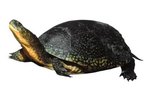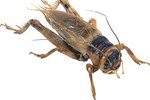
Big and prehistoric-looking with pointed jaws, claws, and a rock-like shell, the alligator snapping turtle is the right pet for you if you want an animal that's not to be messed with. While undemanding in regular maintenance, Macroclemys temminckii requires an experienced turtle keeper who is able to deal with this animal's curmudgeonly nature.
Aquarium Requirements
Alligator snappers can weigh 35 to 70 pounds for females and up to 200 pounds for males, with a carapace of 15 to 25 inches. Turtles this large need a very big home -- a 200-gallon tank is the minimum size for an adult. An outdoor pond, stock tank, or 800-gallon tank is best for the largest freshwater turtles in North America. Snappers need enough room to stand without touching the surface, swim, and walk in their tank. A strong filter is necessary to keep the water clean because these animals are messy eaters. Alligator snappers in the wild live in running water so a pump will keep water flowing and aerated. Water temperature should be held at 75 to 80 degrees F with a heater and monitored with an aquarium thermometer.
Habitat
Alligator snappers need plenty of water for swimming and eating, as well as land areas to bask. The land area should be big enough for the turtle to move around comfortably. He should be able to climb onto shore easily. A heat lamp should keep the basking area between 85 and 95 degrees F. Your alligator turtle will also need 12 hours a day of light from a UV lamp if he's kept indoors. Logs, stumps, and other underwater structures will keep your snapper feeling safe -- these animals like to have hiding places. Alligator snapping turtles should be housed alone because they can be aggressive toward other animals.
Feeding
Alligator snappers are largely sedentary but still benefit from hunting live prey. Live minnows, feeder fish, worms and shrimp will provide sport and protein for your turtle. A hunting alligator snapper is entertaining to watch -- they open their mouths wide and wiggle their tongues as bait for passing prey. They can also eat cooked chicken, chopped fish, and purchased turtle food. Alligator snappers are omnivores so they should also be provided with produce like lettuce, carrots, berries and bananas.
Maintenance
Alligator turtles are fairly easy to maintain. They need 25 to 50 percent water changes weekly, depending on the size of the habitat. The larger the habitat the less water needs to be changed. Water quality should be monitored for pH, hardness, and temperature. Water pH should be as close to 7.0 as possible. Never remove algae or moss from your turtle because this can damage the carapace. Alligator snappers are a long-term pet -- they can live 20 to 70 years in captivity.
Handling
Due to their sharp jaws and feisty attitudes, alligator turtles should be handled with great care. An adult turtle can easily bite off fingers, and their sharp claws can inflict damage. Because of their aggressive nature, alligator snappers aren't recommended for beginner turtle keepers or potential pet owners who want an animal they can interact with daily. Snappers are not appropriate pets for small children.
References
Resources
Photo Credits
-
Ryan McVay/Digital Vision/Getty Images
Writer Bio
Madeline Masters works as a dog walker and professional writer. In the past she has worked as a fitness columnist, fundraising copywriter and news reporter. Masters won two Pennsylvania Newspaper Association Awards in 2009. She graduated from Elizabethtown College with a Bachelor of Arts in English.



